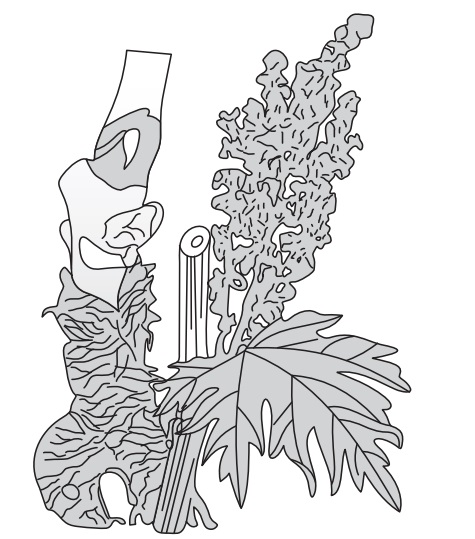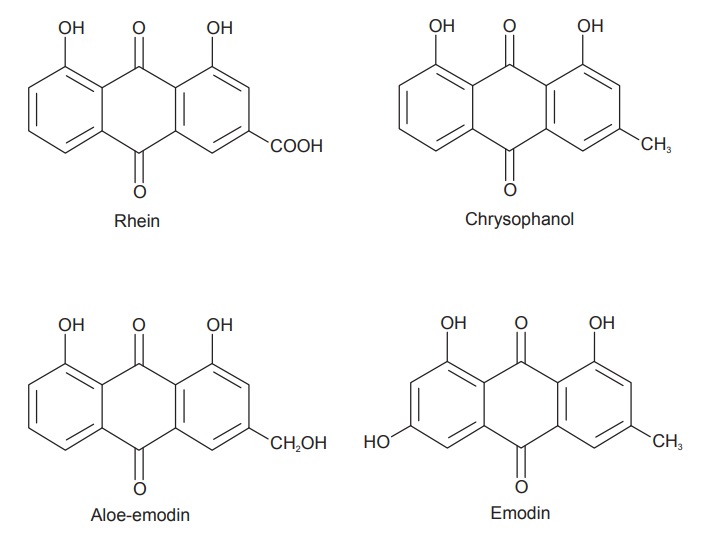Rhubarb
| Home | | Pharmacognosy |Chapter: Pharmacognosy and Phytochemistry : Drugs Containing Glycosides
Rhubarb consists of the peeled dried rhizomes and roots of Rheum palmatum Linn., belonging to family Polygonaceae.
RHUBARB
Synonyms
East Indian Rhubarb, China Rhubarb, Turkey Rhubarb.
Biological Source
Rhubarb consists of the peeled dried rhizomes and roots of Rheum palmatum Linn., belonging to family Polygonaceae.
Geographical Source
It is mainly found in E. Asia, N.W. China in Yunnan, W.
Sichuan, E. Xizang and Gansu, Thibet and India.
Cultivation and Collection
The plant is perennial growing to 3 m by 2 m. The plant prefers medium (loamy) and heavy (clay) soils, requires well-drained soil and can grow in heavy clay soil. The plant prefers acid, neutral and basic soils. Drug is collected from wild plants but is also cultivated to some extent. The plant grows at an altitude of 2,500–4,000 m. It can grow in semishade or no shade. It requires moist soil. Plants can be grown in quite coarse grass, which can be cut annually in the autumn. Seeds are sown in autumn in a shaded cold frame. The seed can also be sown in spring in a cold frame. When large enough to handle, seedlings are pricked out and transferred into individual pots and allowed to grow them on in the green house or cold frame for their first winter, then they are transplanted out in the spring.
The rootstocks are divided in early spring with a sharp knife, making sure that there is at least one growth bud on each division and the required amount of drugs is collected and the remaining are planted.
Rhizomes are large and roots are thick branched, Drug is collected in autumn in September or October from 6 to 15 years old plants. Rhizomes are dug out, crown and lateral roots are removed and the outer bark is separated by peeling. The rhizomes that are small in size are kept as such or cut into transverse slices and so they are round.
Large rhizomes are made flats by making cut into longitudinal slices. These slices are dried by boring holes in the flat pieces and passing thread through the holes and hanging between shades of trees. In absence of the required climatic conditions the drugs are dried artificially heated stones, which are previously heated by woodfire. Drug dried in this way is called high dried. The drugs that are dried in above said manner exerts an unpleasant odour and darker in colour and is considered inferior. The remaining bark is peeled off and graded according to size, shape and quality.
Characteristics
The leaves of the Turkey Rhubarb are palmate and somewhat rough. The root is thick, of an oval shape, sending off long, tapering branches; externally it is brown, internally a deep yellow colour. The stem is erect, round, hollow, jointed, branched towards the top, from 6 to 10 feet high.
This species is distinguished from other Rhubarbs by its much larger size, the shape of its leaves, with their oblong, sharpish segments, and the graceful looseness of its little panicles of greenish-white flowers. The first buds which appear in spring are yellow, not red.
Chinese or Turkey Rhubarb occurs in commerce in brownish-yellow pieces of various sizes, usually perforated, the holes often containing a portion of the cord used to hang the sections of the root on during drying. The outer surface is generally powdery (the bark having been removed) and shows a network of white lines. The taste is astringent and nauseous, and there is a characteristic odour.

Chemical Constituents
Rhubarb contains free anthraquinones, their glycosides, reduced derivatives, anthrones, or dianthrone and heterodi-anthrones. The anthraquinones of rhubarb are chrysophanol, aloe-emodin, emodin, physcion and rhein. Anthrones or dianthrones are of chrysophanol, emodin and aloe-emo-din. Heterodianthrones contain two different molecules of anthrones and they are from above anthrones. It also contains tannoid constituents, starch and calcium oxalate. There are also several resinous matters, one of which, Phaoretin, is purgative, and mineral compounds are also present. The astringency of Rhubarb is due to a peculiar tannic acid (Rheo-tannic), which is soluble in water and alcohol.

Chemical Tests
1. Rhubarb powder when treated with ammonia pink colour is produced.
2. With a solution of 5% potassium hydroxide it gives blood red colour.
Uses
The root is anticholesterolemic, antiseptic, antispasmodic, antitumor, aperient, astringent, cholagogue, demulcent, diuretic, laxative, purgative, stomachic and tonic. The roots contain anthraquinones, which have a purgative effect, and also tannins and bitters, which have an opposite astringent effect. When taken in small doses, it acts as an astringent tonic to the digestive system, whilst larger doses act as a mild laxative. The root is taken internally in the treatment of chronic constipation, diarrhoea, liver and gall bladder complaints, haemorrhoids, menstrual problems and skin eruptions due to an accumulation of toxins. This remedy is not prescribed for pregnant or lactating women, or for patients with intestinal obstruction. Externally, the root is used in the treatment of burns.
Marketed Products
It is one of the ingredients of the preparation known as Diet Master Herb Tea (Health King Enterprise and Balanceuticals Group, Inc.).
Other Rhubarbs
Indian rhubarb
It consists of the dried rhizomes and roots of R. emodi and R. webbianum. R. emodi is a stout herb, 1.5–3.0 m in height, distributed in the Himalayas from Kashmir to Sikkim at altitudes of 3,300–5,200 m. It is also cultivated in Assam for its leaves consumed as vegetable. Roots are very stout.
The drug is collected from the wild plant, found in the hills of Kangra, Kulu, Kumaun, Nepal and Sikkim. The herb is drought resistant, and can be propagated either through rhizome cuttings or seeds. The plant requires deep, rich soil, mixed with well-rotten manure. The cuttings are planted in early spring at a spacing of 1.2–1.5 m beneath the surface. Aerial portions wither away during winter and die, but the rhizomes regenerate during the ensuring spring. Rhizomes and roots are dug up in September from 3 to 10 years old plants. They are washed and cut into pieces of proper size, kiln- or sun-dried, stored in air-tight containers and protected from sunlight.
Indian rhubarb contains a number of anthraquinone derivatives based on emodin, emodin-3-monomethyl ether (physcion), chrysophanol, aloe-emodin and rhein. These occur free and as quinone, anthrone or dianthrone glyco-side. The astringent principle consists of gallic acid, present as glucogallin, along with tannin and catechin. The drug also contains cinnamic and rheinolic acids, volatile oil, starch and calcium oxalate. Free chrysophanic acid, sennoside A and sennoside B are also present. The characteristic odour of the essential oil is due to the presence of eugenol.
R. webbianum contains l,8-dihydroxy-3-methyl-l,8-dihy-droxy-3-hydroxymethyl- and 1,6,8-trihydroxy-3-methyl-anthraquinones and 3’,5-dihydroxy-4-methoxystilbene.
Indian rhubarb is used as a purgative and astringent tonic, in atonic dyspepsia and for cleaning teeth. Powdered roots are sprinkled over ulcers for quick healing.
Chinese rhapontic (Rhapontic rhubarb)
It is obtained from Rheum rhaponticum. Its odour is sweet. It consists of untrimmed pieces sometimes split longitudinally. The transverse surface shows a radiate structure, with con-centric rings of paler and darker colour and a diffuse ring of star spots. The centre may be hollow. The odour, which is sweetish, differs from that of official rhubarb. Rhapontic rhubarb gives a positive test for anthraquinone derivatives. When the test for absence of rhapontic rhubarb is applied, it gives a distinct blue fluorescence, which may be further intensified by exposure to ammonia vapour.
Rhapontic rhubarb contains a glycoside, rhaponticin, which is a stilbene (diphenylethylene) derivative. Rhaponticin and desoxyrhaponticin (glucoside of 3,5-dihydroxy-4’-methoxystilbene) show the difference in fluorescence between official and rhapontic rhubarbs. Rhapontic rhubarb does contain anthraquinone derivatives, although these differ from those in the official drug. One is the glucoside gluco-chrysaron. It also contains 3,3’,4’-5-tetrahydroxystilbene.
Test for Rhapontic rhubarb: An extract of 0.5 g of powder with 10 ml of 45% alcohol for 20 min is prepared. Place one drop of the filtrate on a filter paper. When examined in ultra violet light, the spot shows no blue colour with official Rhubarb but a distinct blue fluorescence; if Rhapontic rhubarb is present. The colour is intensified by exposure to ammonia vapour. Its alcoholic extract on filter paper shows a distinct blue fluorescence in U.V. light due to rhaponticin.
